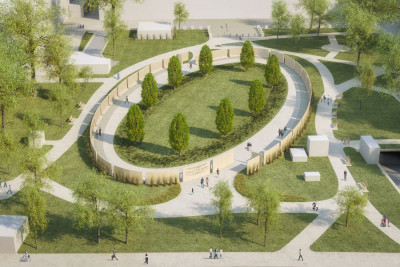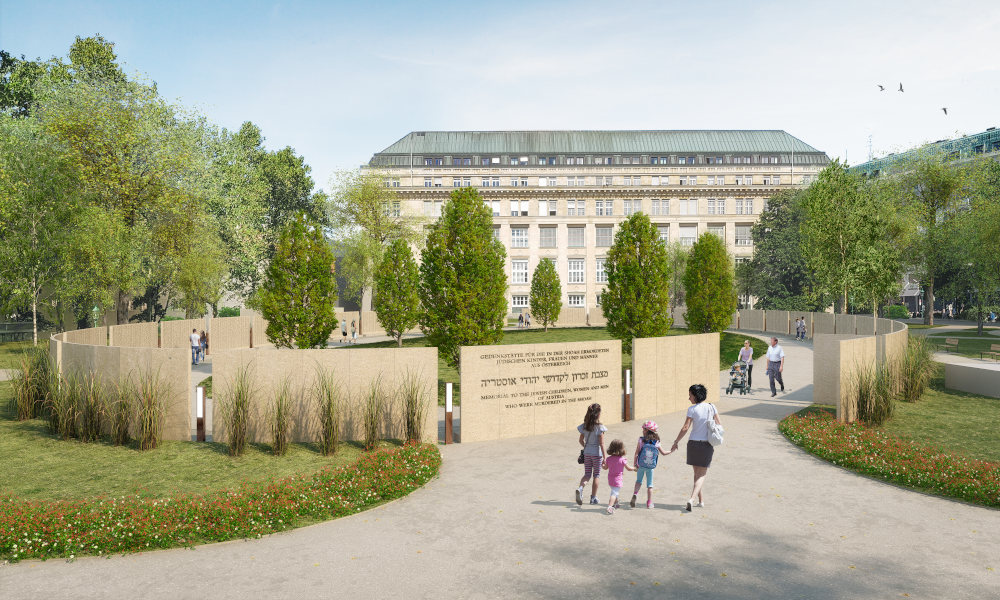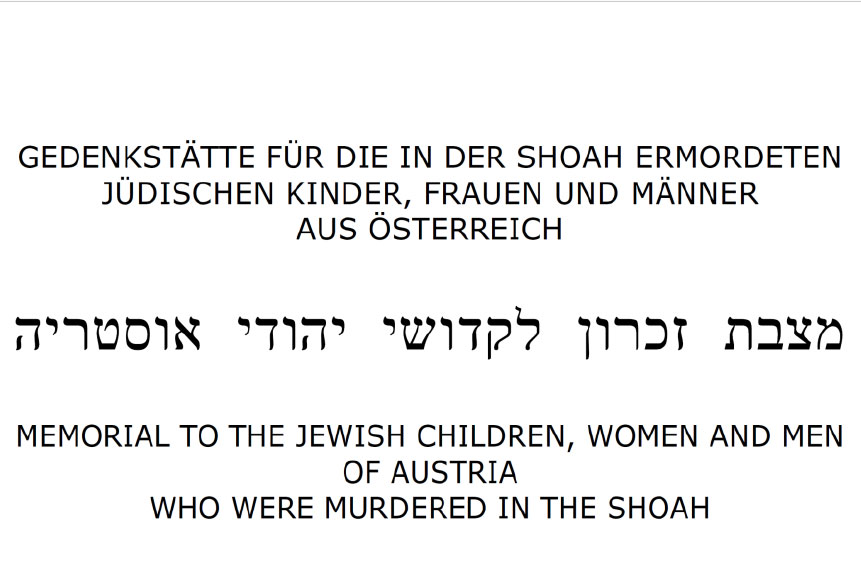Ground-breaking Ceremony for the Shoah Wall of Names Memorial in Ostarrichi Park in Vienna
The responsibility for the historical responsibility with regard to the darkest chapters of Austrian history now finds a visible sign of remembrance of the victims of National Socialism in the Memorial to the Jews from Austria murdered in the Shoah.
 Start of construction of the Shoah Names Walls Memorial in Vienna's Ostarrichi Park: "Creating a society free of anti-Semitism and racism". / Picture: © Wehofer Architekten ZT GmbH
Start of construction of the Shoah Names Walls Memorial in Vienna's Ostarrichi Park: "Creating a society free of anti-Semitism and racism". / Picture: © Wehofer Architekten ZT GmbH


The Shoah Wall of Names Memorial, which was calculated with project costs of around 5.3 million euros, is intended to provide a central as well as quiet place where the fate of the more than 64,000 murdered people can be remembered and their lives honoured.
"The name of a person is inseparably linked to his or her person. At this memorial, at the Shoah Names Walls, we will give back to the murdered Austrian Jews a piece of their personality, a piece of identity and a piece of dignity", said Federal Minister Karoline Edtstadler at an event to mark the start of construction of the Shoah Names Walls Memorial in Vienna's Ostarrichi Park.
In the future, Austria would be judged by the way in which anti-Semitism in all its forms was fought, "on the streets, on the Internet, in our society, in politics. For thoughts become words and words become deeds. In the future, however, we will also be judged by what we do today to create a society free of extremism," stated Edtstadler.
The Austrian population has a special historical responsibility with regard to the darkest chapters of history.
"As Europeans we have a special responsibility to uphold our values: democracy, human rights and the rule of law. In the future, however, we will also be measured by the fact that we will remember the murder of the Jews in Europe not only as an abstract number, but alive in our memories: 64,259 concrete people mentioned by name. So that the memory lives on and is inseparably linked to a person and a personal fate. Today, tomorrow and for future generations", said the Minister, who assured that Federal Chancellor Sebastian Kurz, for whom this project is a matter close to his heart, would do everything in his power to ensure that it was implemented.
Karoline Edtstadler also thanked all those people who "with their imagination and commitment made this important project possible". This includes, above all, the initiator Kurt Tutter.
About the Project
The commemorative year 2018 was the occasion for the Republic of Austria to intensively deal with even the darkest chapters of history.
With the planned memorial for the Jewish children, women and men from Austria murdered in the Shoah, a visible sign of remembrance of the victims of National Socialism is now being set.
The Shoah Name Walls Memorial is intended to provide a central and quiet place where the fate of the more than 64,000 murdered people can be remembered and their lives honoured.
The National Fund of the Republic of Austria for Victims of National Socialism has for years supported efforts to create such a place of nominal remembrance. On the initiative of the Austrian Holocaust survivor Kurt Yakov Tutter and the Verein zur Errichtung einer Shoah Namensmauern Gedenkstätte, the implementation of this important remembrance project could begin in 2018.
It is of particular importance for the association to be able to implement this remembrance project together with the Federal Government, the Federal Provinces, the City of Vienna and the Austrian National Bank under the patronage of the President of the National Council.
The major part of the financing is provided by the Federal Government, following a corresponding commitment by Federal Chancellor Sebastian Kurz in 2018.
In addition, the Federal Provinces and the Federation of Austrian Industry (Fundraising Dinner) have contributed to the realisation of the project.
The project costs of around 5.3 million euros are being financed with contributions from all the bodies involved:
Contributors
- Federal Chancellery - Decision by the Council of Ministers, March and November 2018 Euro 4.460.000
- Federal States - Resolution of the Conference of Governors, November 2018 Euro 600,000
- Donations Industrialists' Association Fundraising Dinner, September 2018 Euro 230,000
- Total amount Euro 5,290.000
Wehofer Architekten ZT GmbH is responsible for the design planning and realization of the memorial. Bundesimmobiliengesellschaft m.b.H. was commissioned with the construction management for the project. The National Fund of the Republic of Austria was entrusted with the administration of finances including public subsidies, donations and expenses.
The memorial will be built on the grounds of Ostarrichi Park in front of the Austrian National Bank. The design for the new memorial envisages an elliptical shape consisting of several stone walls into which the more than 64,000 names of the Austrian Jews murdered in the Holocaust will be engraved.
On November 9, 2018, a symbolic ceremony for the realization of the memorial took place in Ostarrichi Park in the presence of Kurt Yakov Tutter. The importance of this moment was underlined by the presence of representatives of public life, including Federal Chancellor Sebastian Kurz, President of the National Council Wolfgang Sobotka and Vienna City Councillor for Culture Veronica Kaup-Hasler. The coordination of the contractual basis on a technical and legal level was completed at the end of 2019. In the course of the planning process, all authorities, the district and the residents were involved and all steps were coordinated. The association and all the authorities involved are very satisfied with the Ostarrichi Park site.
Parallel to the contract coordination, the submission planning was finalised, work was carried out on the tenders and specialist planning was carried out on the site (statics, surveyors and geotechnics). The tendering process for the stonemasonry and engraving work started in December 2019, and after completion of the tendering process, the stonemasonry and engraving work was awarded to the Breitwieser company at the beginning of 2020. The tender for the master builders was carried out in May 2020. Construction work is scheduled to start in summer 2020 and the memorial is scheduled for completion in late autumn 2021.
Due to the historical significance of this memorial, the City of Vienna and the National Fund will assume joint responsibility for the preservation and ongoing operation of the Shoah Name Walls Memorial.
Initiator Kurt Yakov Tutter and the association
Initiator and author of the Shoah Name Walls Memorial is Kurt Yakov Tutter, born in Vienna in 1930, who fled with his family to Belgium in 1939, where he survived the Holocaust together with his younger sister Rita with the help of a Belgian family. In a video for the Federal Chancellery he described himself as a "echtes Weana Kind".
Initiator and author of the Shoah Name Walls Memorial is Kurt Yakov Tutter, born in Vienna in 1930, who fled with his family to Belgium in 1939, where he survived the Holocaust together with his younger sister Rita with the help of a Belgian family. In a video for the Federal Chancellery he described himself as a "real Weana Kind".
In May 2000 Kurt Yakov Tutter founded an initiative group to promote and realize the project of a Name Wall Memorial. In the following years, prominent Austrians assured the project of their support. In May 2006, the "Association for the erection of a Name Wall Memorial to the Jewish children, women and men from Austria murdered in the Shoah" was founded together with the initiative group.
The Association for the Shoah Name Wall Memorial in Ostarrichi Park
"The National Socialists and their numerous supporters relentlessly persecuted various groups of victims and cruelly murdered many people. They became victims of typical National Socialist injustice for political reasons, because of their descent, religion, nationality, sexual orientation, physical or mental handicap, or the accusation of so-called asociality, or for other reasons.
These name plaques are intended to keep alive the memory of the more than 64,000 Jewish children, women and men who lived in Austria and were murdered in the Shoah, and also to send a visible signal that Austrian society today - after many decades of repression and denial - is acknowledging the darkest sides of its history, the years of National Socialist tyranny, and is taking responsibility for the victims of this regime, which was also supported by many Austrians.
Self-critical remembrance work is an integral part of a liberal parliamentary democracy, and every generation should face up to this discussion process.
Design of the Memorial
The architectural design idea for the memorial was prepared by Univ.-Prof. Dr. John Cirka in an elliptical form of natural stones. The Viennese architect Prof. Dipl.-Ing. Wolfgang Wehofer further worked on the final design of the memorial.4 The elliptical form was inserted into the existing Ostarrichi Park, in the form of a design derived from two interlocking hands. In the middle of the memorial there is a "green island", which is planted with nine trees.
The memorial extends over a total area of about 2,500 m² and consists of natural stone walls with an arch length of about 187 running metres, in which the names of the Austrian Holocaust victims are engraved. The memorial is accessed from the south by Alser Straße and from the north by the Austrian National Bank. The architectural design provides a protected retreat for commemoration. A constant "passage" is prevented by the "green island" in the middle of the memorial.
The wall segments each consist of five walls, each 101 cm wide. These are lined up at a distance of approx. 57 cm in an elliptical shape. The height of the walls of 235 cm allows a height of 190 cm for the engraving area. The edge distance is 5 cm from the upper, left and right side. In the lower area, engraving is possible from a height of 40 cm, measured from the adjacent floor covering. The very high number of individual letters and numbers (over 1 million characters) essentially influences the dimensions of the individual walls.
The memorial is located in the inner city structure, in the middle of the Ostarrichi Park, above two underground car parks on a formerly unplanted green area. The existing park paths around the memorial are to remain unchanged as far as possible.
For the natural stone walls, granite with a polished surface was chosen. The names of the Shoah victims are engraved with a font height of 14 mm using Computerized Numerical Control (CNC) milling. The engraving of one letter takes about 3-5 minutes. The weight of the stone slabs is about 780 kg/rm.
The names of the Shoah victims - data source
The data basis for the Name Wall Memorial is the Shoah Victims Database of the Documentation Archive of Austrian Resistance (DÖW - Dokumentationsarchiv des österreichischen Widerstandes). Within the framework of the project "Naming of Austrian Holocaust Victims" initiated by the Israeli Yad Vashem Memorial and commissioned by the Austrian Ministry of Science and co-financed by the National Fund, the DÖW records the biographical data and death circumstances of around 62,000 Austrian Holocaust victims from 1992 to 2001. After years of intensive research, the DÖW's Shoah victim database contains data on 64,259 persons.
Additional plaques - commemoration of all NS victims
In addition to the stone walls with the dates of the Shoah victims, an additional plaque commemorates all other groups of victims and persecutees of National Socialism. In addition, the idea for the memorial site and the history of its creation should also be described on an additional plaque; on this plaque, the supporters of the project will also be named.
Location Ostarrichi Park
In the original plans the memorial at Schmerlingplatz in the 1st district of Vienna was to be built. After negotiations between the Federal Government, the City of Vienna and the Association, the authorities involved agreed on the new location at Ostarrichi-Park in the 9th district of Vienna. The memorial will be located on a green area in front of the Austrian National Bank, which was named on May 2, 1996, according to the municipal committee for culture, after the oldest name form in Austria, Ostarrîchi, which was documented on November 1, 996. The green area is bordered by the building of the Austrian National Bank, the campus of the University of Vienna (Altes Allgemeines Krankenhaus), Alser Straße or the Vienna Regional Court, as well as by Otto-Wagner-Platz, Haulerstraße and Frankhplatz.
The association commented on the new location as follows: "In order to do justice to the Shoah Name Walls Memorial, it was necessary that it be erected at an important location in the city centre of Vienna, where it is easily accessible to a broad public. But the location should also convey the tranquillity that a place of worship requires. The Ostarrichi Park meets these important requirements in an excellent way".
In the immediate vicinity of the future memorial at Ostarrichi Park there are other memorials in memory of the victims of National Socialism. On 21 April 2015, the memorial "369 Weeks" was unveiled at the Vienna Provincial Court, which is intended to commemorate the victims of Nazi justice who were executed by the Nazi regime at the Vienna Provincial Court.6 On the campus of the University of Vienna, the former Jewish prayer house, which was desecrated by the Nazis in 1938 and used as a transformer station after the war until 2000, was reopened on 20 October 2005 as a walk-in memorial "Marpe Lanefesch". The naming was done in cooperation with the Israelitische Kultusgemeinde. In Hebrew, "Marpe Lanefesch" means "healing for the soul". Since 2009 the "Memorial Book for the Victims of National Socialism at the University of Vienna 1938" has been kept there. In addition, numerous "stones of remembrance" have been laid in the streets in the immediate vicinity of the memorial site.



